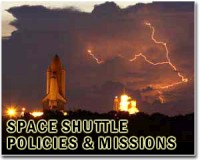 |
Cape Canaveral, Florida (AFP) Feb 24, 2011 Six American astronauts climbed aboard Discovery on Thursday as the most journeyed US shuttle counted down to its final odyssey in orbit, closing a chapter on the US space program. Discovery was set to launch at 4:50 pm (2150 GMT) on an 11-day mission to the International Space Station (ISS), and when it returns next month it will be the first of the three-member fleet to enter retirement. The end of the US space shuttle program creates a gaping hole in the US space program during a period of belt-tightening and budget freezes and leaves Russia's space capsules as the sole transit option to the ISS. "Bittersweet" was the word of the day at Kennedy Space Center as astronauts, engineers and space fans crowded in to get a glimpse of history by watching Discovery's crowning launch 27 years after it first flew into space. "There is no doubt the space shuttle is an engineering marvel. People have dedicated their lives for decades to build and operate the space shuttle -- these are some of the greatest engineers and scientists that our nation has," said NASA chief technologist Bob Braun. "But it is an older vehicle, it is 30 years old, it was designed probably a decade before that," he said. "I think we all recognize we need to go to the next chapter. But any time you go to that next chapter, it is bittersweet." The shuttle will bring a spare closet module and the first humanoid robot to the ISS. The mission will also include two spacewalks. Hours before launch, the European space agency's Johannes Kepler robot freighter docked at the ISS carrying supplies. When Discovery wraps up this tour, the oldest surviving shuttle will have flown more missions than any of its cohorts and toted 180 people into space, including the first female shuttle commander and the first African-American spacewalker. The other two shuttles are scheduled for their final flights later this year: Endeavour on April 19 and Atlantis on June 28, though funding for Atlantis remains in question. The weather was sunny and breezy ahead of the launch and technical checks proceeded smoothly, US space agency NASA said, offering no hint of the problems that delayed Discovery's planned launch in November. Cracks on Discovery's bright orange external fuel tank emerged just before launch more than three months ago, causing engineers to puzzle for many weeks over the cause and how to fix it. In January, they agreed that installing small metal strips, called radius blocks, on the 6.7-meter (22-foot) U-shaped aluminum brackets would reinforce their strength. Discovery has broken new ground multiple times since it first launched in 1984. It transported the Hubble Space telescope, was the first to rendezvous with the Russian Mir Space Station, and delivered part of the Japanese Kibo lab to the ISS. The shuttle was also the first to return to space after two major disasters: the Challenger explosion in 1986 and the Columbia disaster in 2003 when the shuttle broke up on its return toward Earth. Rachel Wiedemann, a Boeing lead engineer charged with monitoring the shuttle's thermal protection shield, said the launch will be emotional. "This is the vehicle I am closest to, that I have the most experience working with," said Wiedemann. "It's my baby." Watching Discovery's last blast off will be "a bit sad for me but launch in general is such an exciting time," she said. The crew plans to deliver the Permanent Multipurpose Module, with extra storage space and an area for experiments, as well as some spare parts and the Express Logistic Carrier, an external platform for large equipment. The shuttle will also bring the first humanoid robot to the ISS. The Robonaut 2, or R2, is a joint project of General Motors and NASA and will stay behind as a permanent resident of the space station when Discovery leaves. Discovery has circled the Earth more than 5,600 times and logged 142 million miles (230 million kilometers) over its 352 days in space.
Share This Article With Planet Earth
Related Links Shuttle at NASA Watch NASA TV via Space.TV Space Shuttle News at Space-Travel.Com
 Discovery shuttle poised for last launch
Discovery shuttle poised for last launchCape Canaveral, Florida (AFP) Feb 24, 2011 Discovery, NASA's oldest and most journeyed space shuttle, is poised to launch Thursday on its final mission to the International Space Station, wrapping up a near three-decade legacy of orbital travel. When the storied spacecraft lifts off at 4:50 pm (2150 GMT), it will mark the beginning of the end of the US space shuttle program, with Discovery the first of the remaining three shuttles he ... read more |
|
| The content herein, unless otherwise known to be public domain, are Copyright 1995-2010 - SpaceDaily. AFP and UPI Wire Stories are copyright Agence France-Presse and United Press International. ESA Portal Reports are copyright European Space Agency. All NASA sourced material is public domain. Additional copyrights may apply in whole or part to other bona fide parties. Advertising does not imply endorsement,agreement or approval of any opinions, statements or information provided by SpaceDaily on any Web page published or hosted by SpaceDaily. Privacy Statement |